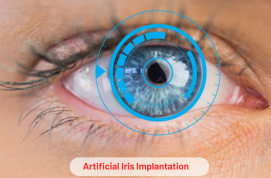An artificial iris implantation treatment is associated with iris the color of eyes. The implantation surgery is recommended to the patients when their iris tissues are completely lost due to trauma and congenital aniridia. In simple words, an artificial iris implant is a medical procedure performed to change the color of the iris. Typically an iris implant can be used for both cosmetic and therapeutic purposes but initially it is used for therapeutic purposes. Although in recent times, the treatment is opted by many people to fulfill their cosmetic desire as well. On the other hand the therapeutic use of an artificial iris implant is done when the natural iris undergoes degeneration or damage.
Many individuals suffering with iris defects see several images ranging from clear to blurred. Quality of life in these patients is significantly reduced and the problem in iris also impacts visual contrast. The condition becomes more complex when these symptoms are clubbed with halos, glare, and increased light sensitivity. The light entering in the eyes of these patients is de-focused that impacts the quality of vision. Therefore, to cure the problem the surgeon remove the natural damaged iris and replace it with artificial iris to improve the eye vision of the patient.
Artificial Iris Implantation Causes
There could be several factors which contribute to iris defects. The primary causes are :
a) Congenital Aniridia- It is a genetic disorder which affects newborn babies. In this condition babies are born without or abnormal iris. This leads to extreme light sensitivity and various vision related concerns in children.
b) Traumatic Injury- Sometimes injuries and accidents also become the reason of damaged iris. This can happen from a blunt force impact, penetration of sharp objects and chemical exposure.
c) Iris Atrophy– Specific medical conditions like Fuchs’ heterochromic iridocyclitis and other inflammatory diseases can cause gradual atrophy that affects the iris functioning.
d) Post- surgical complications – In rare cases like surgeries like cataract operation or glaucoma treatments can also unintentionally damage the iris.
Artificial Iris Implantation Cost In India
An artificial iris implantation treatment cost ranges from 4, 50,000 to 5,00,000 rupees in India. However, the overall cost depends on various factors which Include:
- Hospital Type
- Type of Implantation
- Pre-operative care
- Surgeon Expertise
- Complexity of the Case
- Overall examination and tests cost
- Hospital Location
Benefits of Artificial Iris Implantation
Following are the main benefits of availing Artificial Iris Implant treatment:
1. Enhance Vision
By regulating the amount of light that enters into the eye. An artificial iris improves the vision of a person. It helps especially in bright or glare-prone environments. This can be more beneficial for those individuals who are suffering with photophobia. Moreover, it assists in enhancing the clarity and sharpness of vision by allowing the pupil to adjust properly in changing light conditions.
2. Long-Term Results
Unlike other treatments which might require frequent adjustments or replacements, An artificial iris implant is designed for long treatment making it a durable solution for iris defects.
3. Improved Aesthetic Appearance
One of the most key benefits of availing artificial iris implant treatment is that it can restore the natural appearance of the eyes. Children who are born with congenital aniridia or those who have lost their iris due to an accident often feel under confident about their look. Hence,, an artificial iris implant can restore a more natural look, significantly boosting self-esteem and confidence for them.
4. Better Quality of Life
With improved vision and appearance, many individuals find that they can indulge in activities they had previously ignored due to their vision impairment. Whether it’s driving, reading, or simply participating in social events.
Artificial Iris Implantation Procedure
An Artificial iris implantation is an outpatient procedure usually performed in a hospital which involve following steps:
1. Pre-Surgery Evaluation
Before the procedure the patient needs to undergo an eye examination including imaging testing to assess the overall condition of the eye and determining the suitable fit for the artificial iris. During the evaluation the surgeon also discusses the risks and key benefits of the surgery with the patient.
2. Anesthesia
After evaluation the patient is sent to the operating room where the doctors provide anesthesia to the patient for making him/her relaxed during the procedure.
3. Implantation
Once the doctor gives you anesthesia the surgeon starts the implantation with the help of certain equipment and a team of medical assistants. In this procedure the experienced surgeon carefully places the artificial iris into the eye, using certain medical techniques.
4. Recovery
After the surgery the patients may experience some discomfort and need to wear an eye patch for a few days to improve the vision. Most patients can resume normal activities within a few weeks. Although complete recovery can take a few months as well.
Our Other Services
Latest Health Tips
Can Immunotherapy Cure Stage 4 Lung Cancer?
Early Signs of Cervical Cancer
Foods that Kill Cancer: Leafy Vegetables, Grains, & More
What Stage of Cancer is Immunotherapy Used For?
Which is Worse for Cancer, Sugar or Alcohol?
Vaccines That Prevent Cancer
What Kills Cancer Cells in the Body Naturally?
5 Early Warning Signs of Bone Cancer
Submit Your Enquiry
Testimonials


























